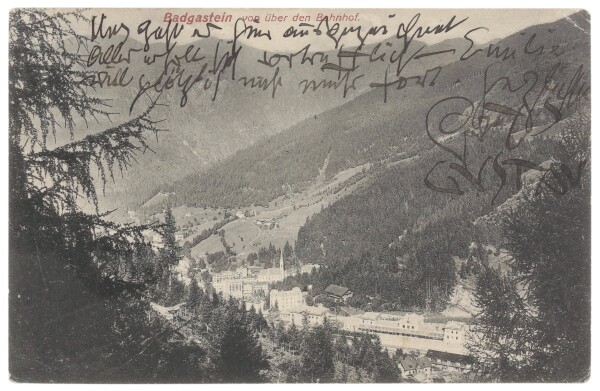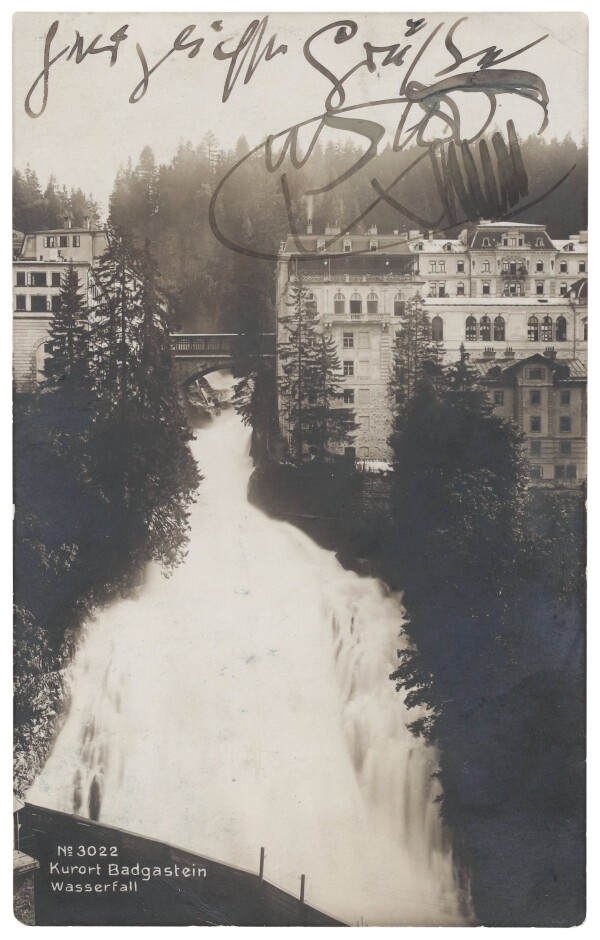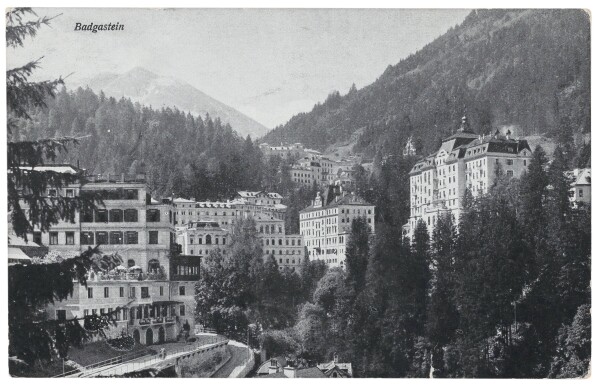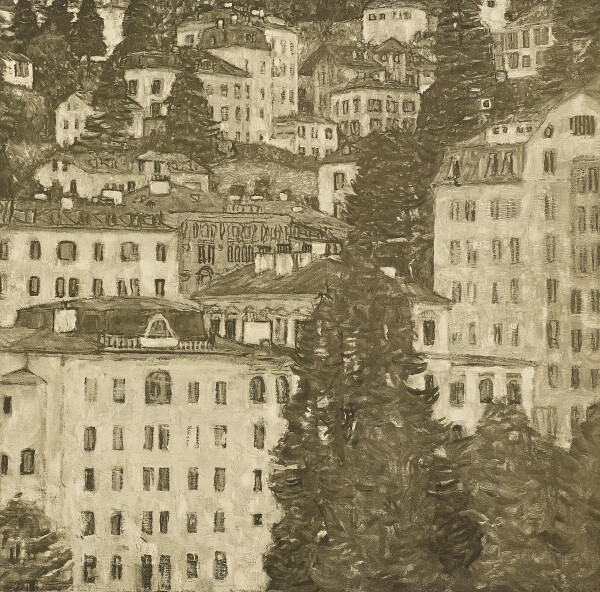Taking the Waters in Bad Gastein

Gustav Klimt: Picture postcard from Gustav Klimt in Bad Gastein to Hermann Flöge jun. in Vienna, 07/12/1912, Privatbesitz, courtesy Klimt-Foundation, Wien
© Klimt Foundation, Vienna

Gustav Klimt: Picture postcard from Gustav Klimt in Bad Gastein to Friedrich Hetzer in Vienna, 07/10/1913, Klimt Foundation
© Klimt Foundation, Vienna

Barbara Flöge: Picture postcard from Barbara Flöge in Bad Gastein to Gertrude Flöge in Vienna, co-signed by Emilie Flöge and Gustav Klimt, 07/03/1916, Sammlung Villa Paulick, courtesy Klimt-Foundation, Wien
© Klimt Foundation, Vienna

Gustav Klimt: Gastein, 1917, Verbleib unbekannt
© Klimt Foundation, Vienna
Gustav Klimt and his life companion Emilie Flöge visited the spa town of Bad Gastein several times to improve their mental and physical well-being. The town’s impressive topography inspired the Jugendstil artist to create a landscape painting that has been presumed lost since the end of World War II in 1945.
The “Monaco of the Alps”
In the late 19th century, Bad Gastein in Salzburg already enjoyed a reputation as a glamorous spa for an international clientele. Even Emperor Franz Joseph I, Empress Elisabeth of Austria and Emperor Wilhelm I regularly took the waters in Bad Gastein. Vigorous construction activity commenced in the last three decades of the 19th century in order to offer enough accommodation for the town’s illustrious guests. All new buildings were designed by the architect Angelo Comini, who was originally from Friuli. Many of these hotel buildings – albeit in a partly transformed state – still dominate the scenery of Bad Gastein today.
“Beautiful landscape – much rain […] clean air – well-being.” Gustav Klimt’s Spa Breaks in Bad Gastein
From 1912, the “most powerful Alpine spa in Europe […] in the midst of the most wonderful and splendid mountain scenery […]” – as Bad Gastein was described in an advertisement in an Austrian tourism magazine in the early 20th century – repeatedly served as a haven of relaxation for Gustav Klimt, who during his stays was mostly accompanied by Emilie and Barbara “Betti” Flöge (née Stagl). They frequently stayed at the Hotel Imperial (now Hotel Residenz) or at its affiliated establishment. Their regenerative vacation in Bad Gastein was often followed by a summer sojourn on the Attersee.
In 1912, Emilie Flöge had arrived at the Villa Imperial before Klimt, as their correspondence from June of that year reveals. In a picture postcard, Klimt reacted to Emilie’s hope that she would soon feel the therapeutic effect of the thermal waters, writing:
“[…] how can you expect to feel the benefits of the spa straight away, you silly thing? Just be glad if you feel some improvement in 3 weeks’ time.”
In early July, just before his arrival in the glamorous spa town, Klimt was still complaining about the prospect of “a boring week” which he was “dreading somewhat” as well as about the weather in Vienna. After a few days of well-deserved regeneration in the Valley of Gastein, he left for the Attersee shortly before his birthday on 14 July.
Klimt stayed in Bad Gastein again in July 1913. That same month, he reported to Franziska Klimt that the weather in Gastein was not to his liking, but that it benefited his health, writing of “shameful weather, but considerable well-being.” Prior to their departure, the spa guests Klimt, Emilie and Barbara Flöge also sent their regards to Emma Bacher-Teschner “from the world’s largest rain belt.” The sojourn in Gastein was followed by an extended stay on Lake Garda and a short visit to the Attersee. In the summer of 1914, Klimt again took the waters in Bad Gastein from late June, before traveling to Weißenbach on the Attersee in July.
After a one-year hiatus, almost the entire July of 1916 was reserved for a sojourn in the spa town of Gastein, together with Barbara and Emilie Flöge. Klimt also visited the fashionable resort, which was dubbed the “Monaco of the Alps,” for an extended period in 1917. In a letter to his client Erwin Böhler dated 10 July, Klimt mentioned that he was planning to travel to Bad Gastein on Sunday, 15 July 1917. In fact, he had rented his room there from 12 July. During this time, Klimt was working on the painting Lady with a Fan (1917/18 (unfinished), privately owned). This work, together with The Bride (1917/18 (unfinished), Klimt Foundation, Vienna) remained on the easel in his last studio in Vienna-Hietzing, 13th District, after his death. His earlier correspondence with Emilie from the same year reveals that the artist was feeling “squished, squashed and strained – afflicted with all the evils of discomfort.” Several weeks in the spa town may have provided some relief.
“[…] the emerald green of the mountain town of Gastein.” Klimt’s Landscape Painting Gastein
Even though the time that Klimt spent with Flöge in the spa town was primarily reserved for regeneration, the unique local topography and atmosphere finally inspired him to create the landscape painting Gastein (1917, current location unknown, presumed lost since the end of World War II in 1945). The painting is first hinted at in a correspondence card with a packing list written by Klimt. This list, probably dating from 1916 or 1917, also contains the item “Gastein sketches,” suggesting that the master painter had made preliminary studies for the painting. Furthermore, Klimt’s last sketchbook, which he used between June 1917 and January 1918 for his so-called “idea studies,” also contains a draft of the Gastein painting. Drawings of conifers in this sketchbook suggest that Klimt was studying the natural landscape around him during his last stay at the spa town.
The painting in a square format, which was an integral part of the Lederer Collection, shows the cascade-like array of hotels on the town’s northwestern slope. The Hotel Waismayr, the Hotel de l’Europe, the Elisabethhof as well as the Wildbad, Reineke, Söntgen and Bellevue hotel buildings can be clearly identified. Klimt probably selected the view with the help of one of his preferred optical tools, his “viewfinder,” which he also frequently used on the Atterseee. Visual impressions of the painting survive in a monochrome collotype from Max Eisler’s 1931 portfolio and in a photograph taken by Moriz Nähr. It is impossible to recreate the coloring chosen by Klimt, but Eisler writes of “white and blackish green, polished ivory and emerald.”
The assumption that the painting was destroyed by fire at Immendorf Castle in 1945 has been repeatedly doubted, since the document “Bergung nach Immendorf der Klimtbilder aus der Sammlung S[erena]. Lederer” [“Transport to Immendorf of the Klimt Paintings from the S[erena]. Lederer Collection”], dated 3 March 1943, in the Immendorf file of the Austrian Federal Monuments Agency does not list this painting. The work was to be presented in 1943 at the “Gustav Klimt Gedächtnisausstellung” [“Gustav Klimt Commemorative Exhibition”] at the Ausstellungshaus Friedrichsstraße exhibition hall (previously Secession). A comparison of the two surviving versions of the catalogue for this exhibition suggests, however, that it was decided at the last moment not to include the work in the final presentation.
Literature and sources
- Dillinger's Illustrierte Rundschau. Blätter für Reise und Fremdenverkehrs-Wesen, 12. Jg., Nummer 18 (1901), S. 15.
- Emil Pirchan: Gustav Klimt. Ein Künstler aus Wien, Vienna - Leipzig 1942, S. 88.
- Alice Strobl (Hg.): Gustav Klimt. Die Zeichnungen, Band III, 1912–1918, Salzburg 1984, S. 239-241, S. 246.
- Stephan Koja (Hg.): Gustav Klimt. Landschaften, Ausst.-Kat., Upper Belvedere (Vienna), 23.10.2002–23.02.2003, Munich 2002, S. 142-143.
- Wolfgang Georg Fischer: Liebe Emilie! Klimt schreibt an Emilie Flöge, in: Tobias G. Natter, Franz Smola, Peter Weinhäupl (Hg.): Klimt persönlich. Bilder – Briefe – Einblicke, Ausst.-Kat., Leopold Museum (Vienna), 24.02.2012–27.08.2012, Vienna 2012, S. 47-50.
- Tobias G. Natter (Hg.): Gustav Klimt. Sämtliche Gemälde, Vienna 2012, S. 580.
- Sandra Tretter: Gustav Klimts Naturvision im Atelier und auf Sommerfrische, in: Sandra Tretter, Peter Weinhäupl (Hg.): Gustav Klimt. Florale Welten, Vienna 2019, S. 27.
- Brief von Gustav Klimt in Wien an Erwin Böhler, DLSTPW11 (10.07.1917), .
- Ansichtskarte von Gustav Klimt in Bad Gastein an Julius Zimpel sen. in Wien (07/11/1912). GKA61.
- Ansichtskarte von Gustav Klimt in Bad Gastein an Emma Bacher-Teschner in Hamburg, mitunterschrieben von Emilie und Barbara Flöge, DLSTPW18 (07/19/1913), .
- Max Eisler (Hg.): Gustav Klimt. Eine Nachlese, Vienna 1931, S. 13.
- Andreas Lehne: Die Katastrophe von Immendorf. Nach dem Archivmaterial des Bundesdenkmalamtes. Sonderband Gustav Klimt, in: Österreichische Galerie Belvedere (Hg.): Belvedere. Zeitschrift für Bildende Kunst (2006), S. 54-63.

